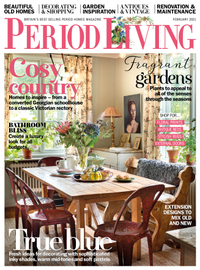‘When I arrived, the garden was like a goldfish bowl in the middle of the village, and looked more like an allotment, planted with well-tended vegetables, grassy paths and a central fruit cage,’ Sue recalls. But once cleared, the less than a quarter-acre garden was a blank canvas, ready to be transformed. Scroll to find out how she created the beautiful cottage garden that so well complements her Victorian cottage in the village of Frittenden, in Kent, southern England. Find cottage garden ideas in our picture gallery – there’s plenty of inspiration to be had. Curvaceous flowerbeds now brim with blooms in this quaint cottage garden, with grassy paths snaking between them. To give privacy and structure, Sue planted trees and shrubs, including hawthorn and holly hedges, a row of pleached limes on the side and a lovely Cercis canadensis on the lawn, which is draped in pink blossom in May. A small formal pond near the house, accompanied by a coppiced chestnut pergola walk, add a lovely touch of linear perspective. Linking the two garden areas is a pergola arch, flanked on both sides by deep curving beds planted in tones of soft blue from clumps of Iris sibirica, and silver-foliaged screening shrubs, such as the scented Elaeagnus ‘Quicksilver’. See: Cottage patio ideas – create a pretty spot for relaxing and entertaining It makes a pretty entrance to the second section of the cottage garden and allows glimpses of what lies beyond.
See: How to grow roses – with tips from a gardening expert
One large area has been divided into quarters with curving, low box hedging for a touch of formality to enclose herbs and flowers, and four raised beds built and planned for crops. A lovely old gnarled ‘Beauty of Bath’ apple tree , the only tree that was on the land when Sue arrived, has remained a feature and is perfect to sit under for a bit of shade in summer, backed with clusters of cascading blooms from the beauty bush, Kolkwitzia amabilis ‘Pink Cloud’. The cottage garden has evolved organically over the years into a pretty, informal style; full of plants, but with no set plan and simply embracing Sue’s love of gardening. ‘I tended to collect lots of plants and then I would gradually make beds for them; it was a bit of hit and miss,’ Sue explains. Subscribe to Period Living (opens in new tab) for more inspiration. A subscription provides you with all you need to know about caring for and improving a traditional house and garden.
See: Monty Don’s beautiful Longmeadow Garden in Herefordshire
Hardy perennials really fascinated her, and so she joined the local Hardy Plant Society in the 1980s. It was reading Beth Chatto’s Garden Notebook, however, that sparked the particular plant passion that informs this garden. ‘I was inspired to do a yellow border, and when looking around for something suitable bought a deep yellow Geum montanum. It seemed perfect, but not knowing much about geums then, I didn’t realise that it is an alpine plant and it didn’t like sitting in heavy Wealden clay, so it soon disappeared,’ Sue explains. ‘Then I saw Geum ‘Prinses Juliana’, and although I didn’t think I liked orange at first, it has been wonderful as it flowers and flowers and was much more successful. ‘I gradually found other geums; whenever I saw one on a stall I would buy it,’ she continues. As there aren’t many geum cultivars available in garden centers, Sue visited the holder of a National Collection in Devon, and eventually took on the collection in 2006. Today she has 119 different cultivars of geums meticulously recorded, with some for sale in her small nursery on site. Geums fill the cottage garden, mingling with perennials and annuals in flowerbeds, and planted en masse in a sea of forget-me-nots in the four raised beds that were once destined for vegetables. Planting combinations are a little bit random, with a spontaneous charm that is quite enchanting as this cottage garden is filled casually with exuberant, much cherished plants. ‘I now grow a lot of annuals, which I hadn’t before as the beds are full of perennials – with choices such as ammi, cosmos, rudbeckias, larkspur and antirrhinum, says Sue. Some flowers prolifically self-seed, such as ox-eye daisies, ‘which are everywhere,’ says Sue. In mid-spring there are also tulips popping up, spires of Allium ‘Purple Sensation’, Dutch iris, promiscuous aquilegia, and centaurea, adding to the repeated visual link of sunny geums and the froth of forget-me-nots. Later in the season, salvias, dahlias and chrysanthemums continue the show. ‘The aim is for continuous planting along the lines of the Great Dixter design,’ Sue says.
See: How to grow dahlias - a step by step guide to growing dahlias from tubers
As the cottage garden continues to evolve, curvaceous beds will continue to encroach further on the lawns, as new plants need to be accommodated in this floral melody. ‘I can’t resist plants and keep needing to find a home for the new arrivals,’ Sue adds. ‘They are what inspire me.’
